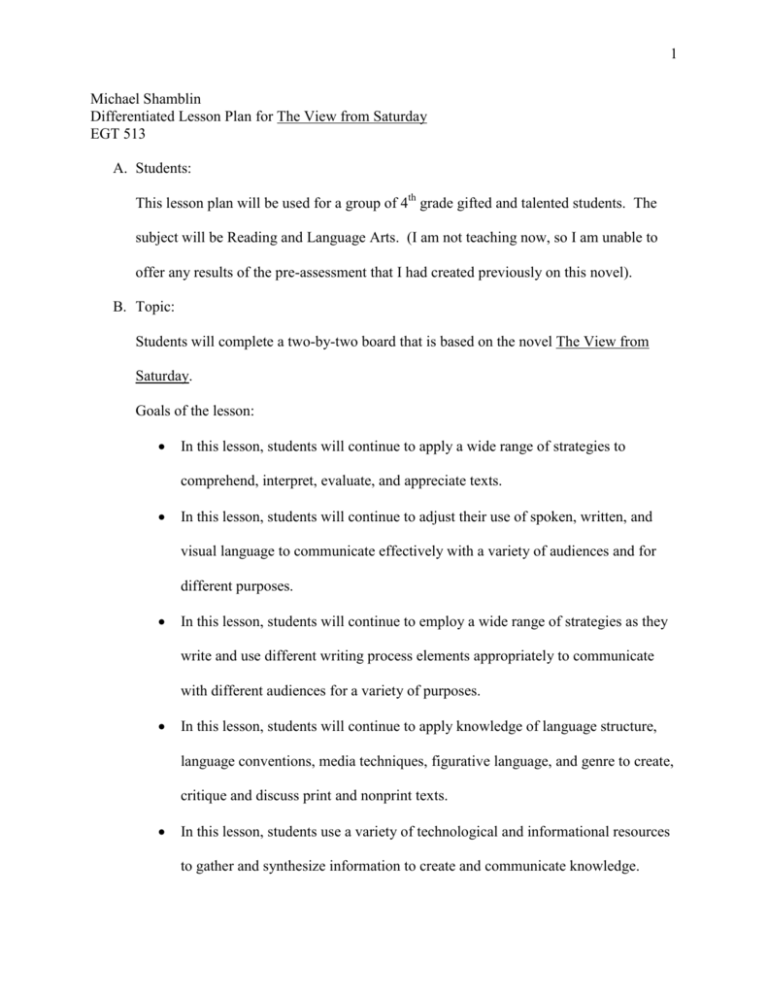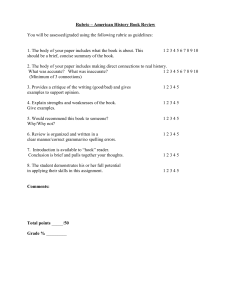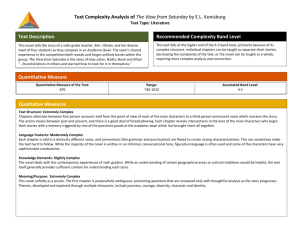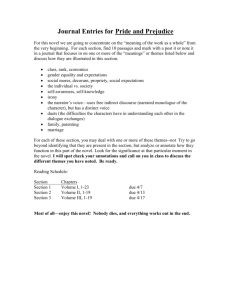1 Michael Shamblin Differentiated Lesson Plan for The View from
advertisement

1 Michael Shamblin Differentiated Lesson Plan for The View from Saturday EGT 513 A. Students: This lesson plan will be used for a group of 4th grade gifted and talented students. The subject will be Reading and Language Arts. (I am not teaching now, so I am unable to offer any results of the pre-assessment that I had created previously on this novel). B. Topic: Students will complete a two-by-two board that is based on the novel The View from Saturday. Goals of the lesson: In this lesson, students will continue to apply a wide range of strategies to comprehend, interpret, evaluate, and appreciate texts. In this lesson, students will continue to adjust their use of spoken, written, and visual language to communicate effectively with a variety of audiences and for different purposes. In this lesson, students will continue to employ a wide range of strategies as they write and use different writing process elements appropriately to communicate with different audiences for a variety of purposes. In this lesson, students will continue to apply knowledge of language structure, language conventions, media techniques, figurative language, and genre to create, critique and discuss print and nonprint texts. In this lesson, students use a variety of technological and informational resources to gather and synthesize information to create and communicate knowledge. 2 C. Objectives Reading Process: Concepts of Print, Comprehension Strategies and Self-Monitoring Strategies The students will be able to compare and contrast two characters from the novel The View from Saturday with 95% accuracy. Writing Applications The students will be able to produce informal writings from the novel The View from Saturday with 95% accuracy. The students will be able to write narratives that sequence events, including descriptive details and vivid language with 95% accuracy. D. Procedures This lesson will be designed based on the Autonomous Learner Model. This model enables students that are dependent on teacher direction to become autonomous learners that are capable of self-directed, lifelong learning. Student’s independence and choice are an advantage of this model. The lesson will be completed in three class periods (4045 minutes for each class). 1. Students completely read the entire novel The View from Saturday. 2. Hand out two-by-two board. Students in previous lessons had worked on a two-bytwo choice board. The basic level will allow for the use of construction paper, pencils, crayons, and loose-leaf paper only. The advanced level will require a computer with internet access and the use of the Microsoft Office software. 3. Hand out the rubric and discuss how the assignment will be graded. 3 4. Allow students three class periods of 40-45 minutes to work on and complete the choice board. If they are not complete after the third day, they may continue working on the assignment for homework. E. Products Students will work on a two-by-two choice board. This board will offer two rows with two activities each that will offer four choices for fourth grade gifted students. Students must complete one box on each board and then students will select one of the remaining three assignments that they will complete. Each student will complete two assignments total. The advanced level board will allow for students that need greater enrichment. F. Materials Construction paper, pencils, crayons, loose leaf paper, computer with internet access, Microsoft Office Software, handouts on the two-by-two board, The View from Saturday, and gifted and talented students. G. Evaluation I will walk around and observe the students when they are working on the independent assignment. Students will be given a rubric that will assess them on how well they completed the activity. The rubric will be assessed on four categories: score incomplete (0), satisfactory (3.5), Good (4.5), and Superior (6). Since they will complete two activities, they will each have two rubrics. H. Reflection 4 I am not in the classroom now, but when I do have the opportunity to teach this lesson, I would like to instruct this lesson at the 4th grade level. I tried to be as clear as possible with my attached two by two board and the rubric that I will give to assess the students on the lesson activities. I am also thinking about allowing the students to evaluate each other’s project using the same rubric. *Pages 5-7 of the word document contain the two-by-two board along with the rubric 5 Two-by-Two Board English/Language Arts Elementary Basic Level 1.Compare/Contrast two characters of your choice (may use a graphic organizer). 2. Construct a crossword puzzle using ten words from the novel. 3. Create a new ending to the story. 4. Draw a comic strip to present three key facts from the novel. Advanced Level 1.Create a PowerPoint slide show of ten slides comparing/contrasting two characters of your choice. 3. Create a new ending to the story in first and third person using Microsoft Word. Include page numbers; double spaced, Times New Roman and 12-font size. 2. Construct a crossword puzzle using Microsoft Excel using fifteen words from the novel. 4. Use Microsoft Word to create a comic strip to present three key facts from the novel. Insert graphics using word, copy/save graphics from the internet, or create your own. 6 Name:___________________________________ General Grading Rubric Superior (6) clearly meets all criteria set out in the instructions interesting and also entertaining very clearly presents a message showing insight or imagination shows careful planning and organization of material interesting details to support major points no errors in grammar, spelling, or structure (if written) easily understood examples, well presented with colorful illustrations (if appropriate) Good (4.5) meets the criteria set out in the instructions holds interest shows evidence of planning and organization clearly presented ideas includes detail a few errors neatly completed illustrations (if required) or examples Satisfactory (3.5) meets the criteria set out in the instructions can be understood and followed evidence of some planning little effort made to create interest occasionally difficult to follow quite a few errors neatness needs attention lack of illustrations (if required) or examples 7 Incomplete (must be redone or completed) (0) many errors messy and lacks organization little or no specific content no attempt to create interest generally poor preparation little thought given toward completion








